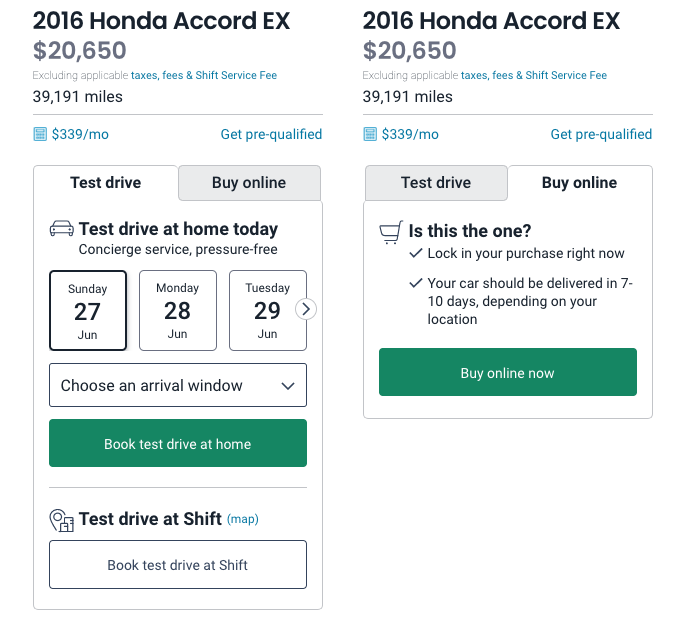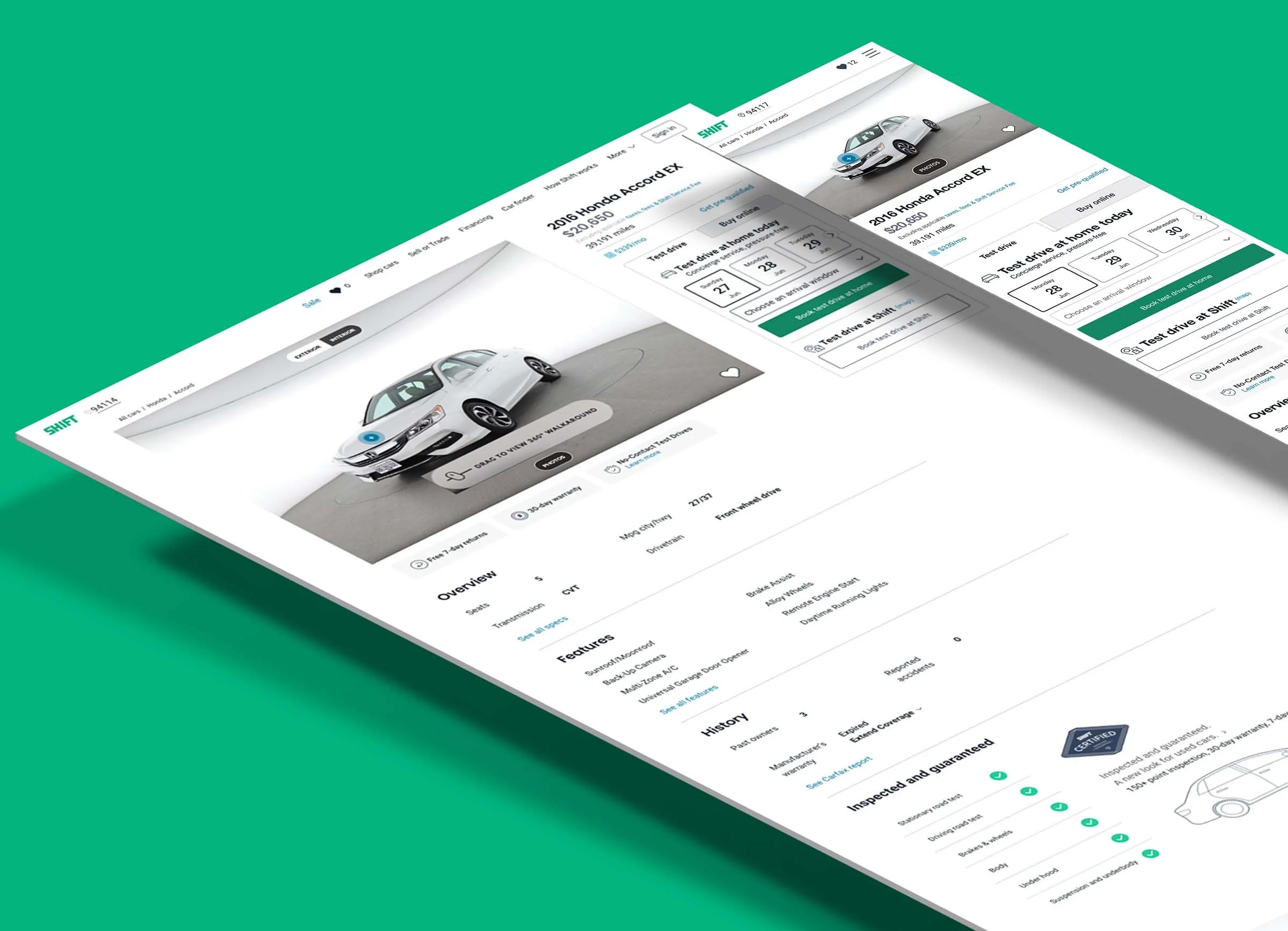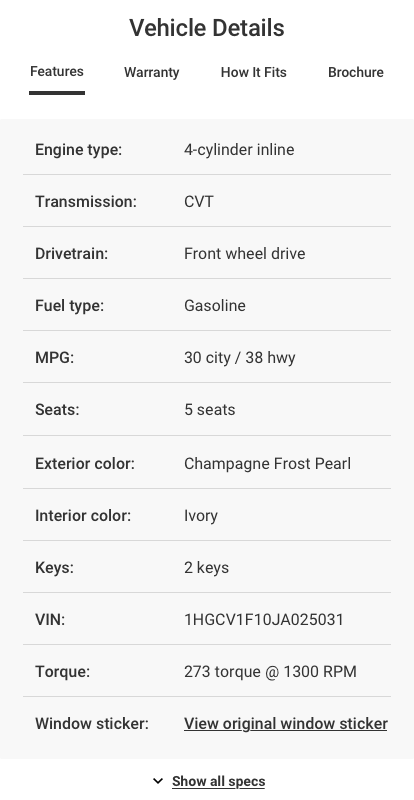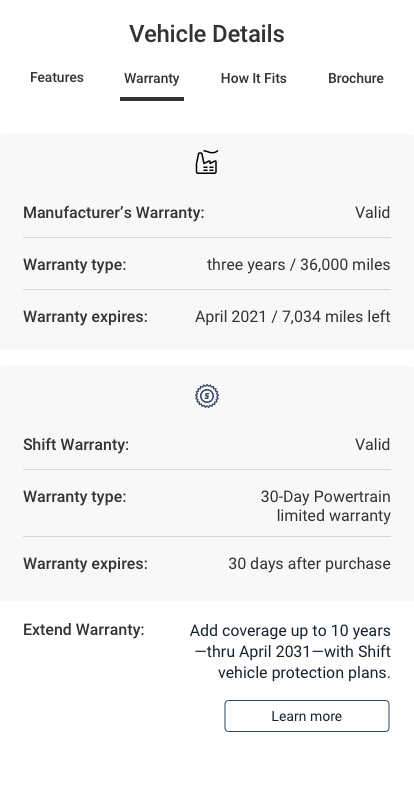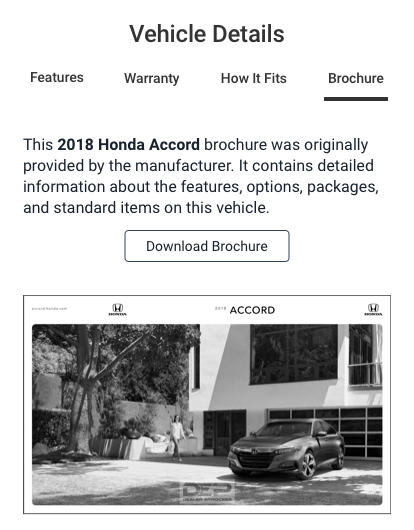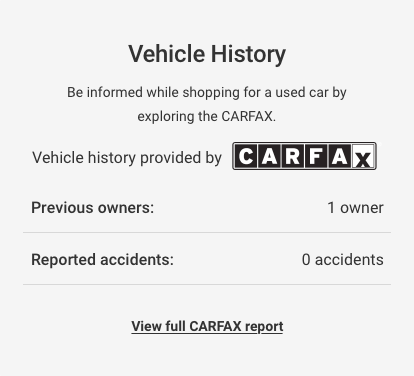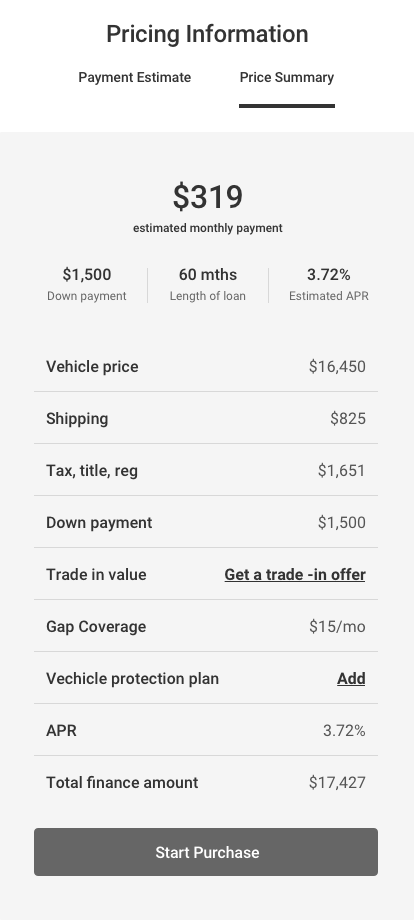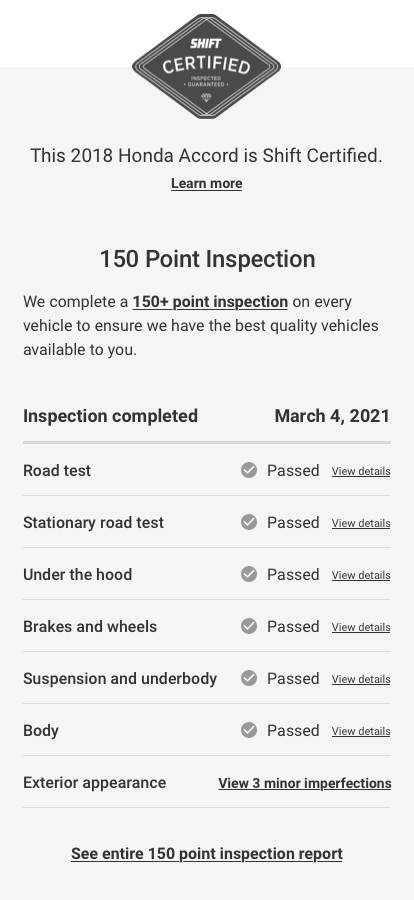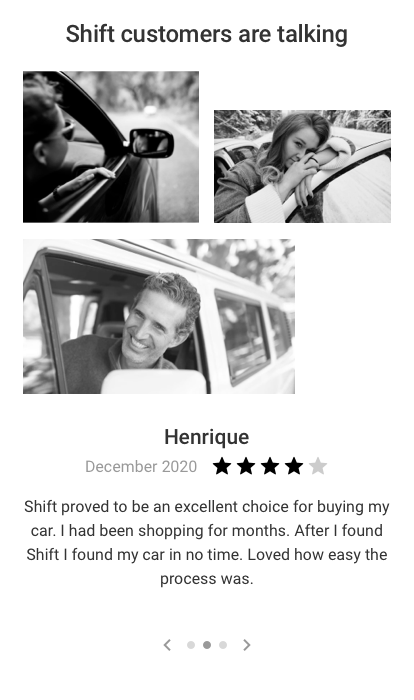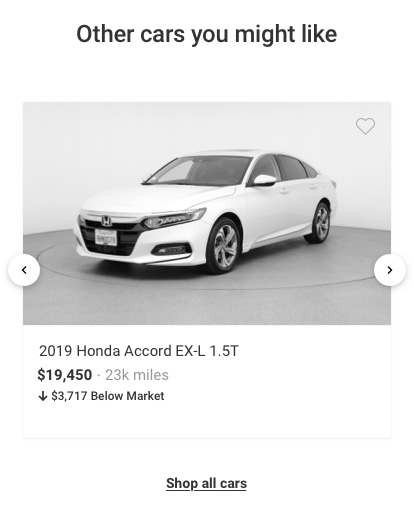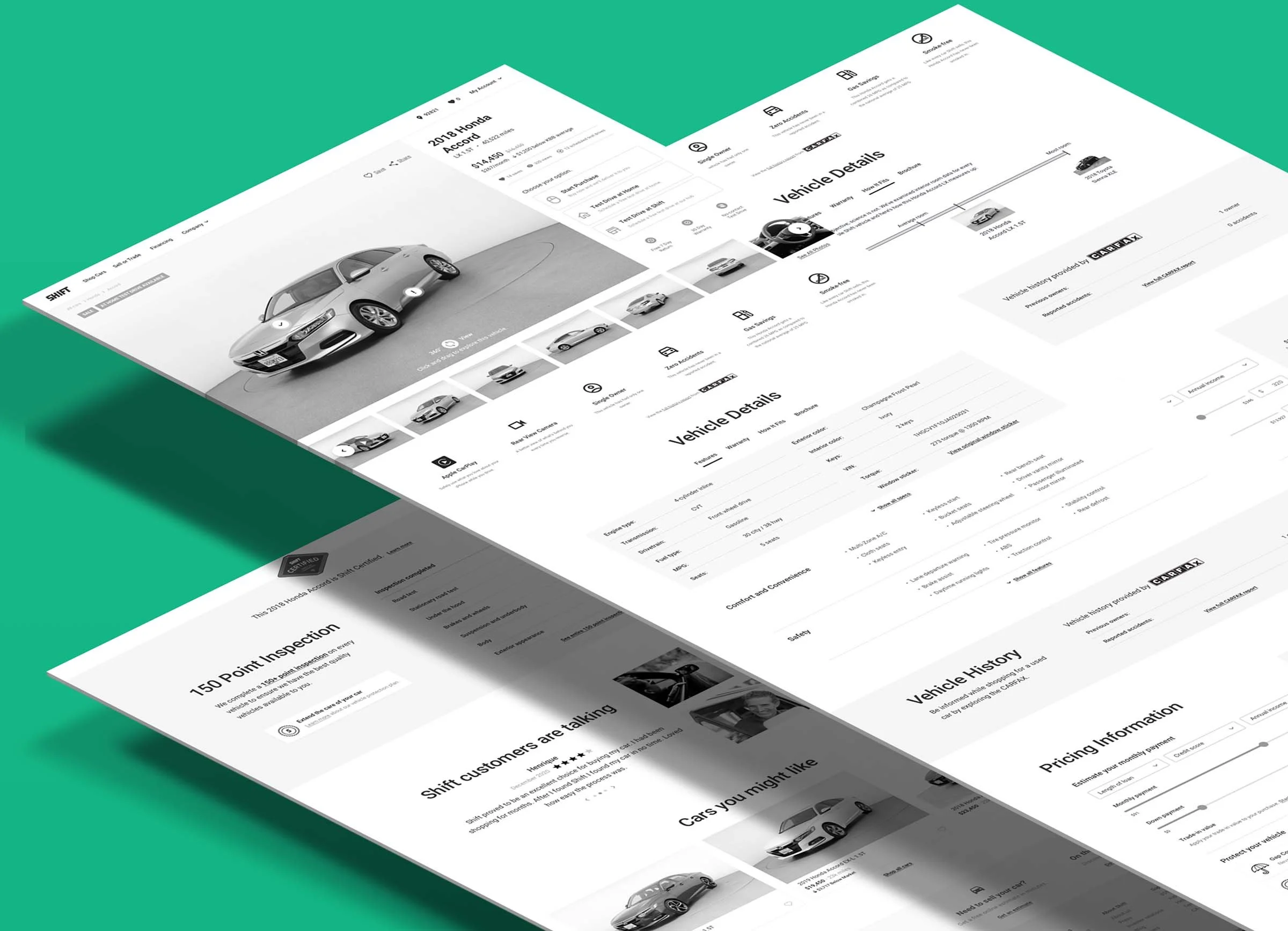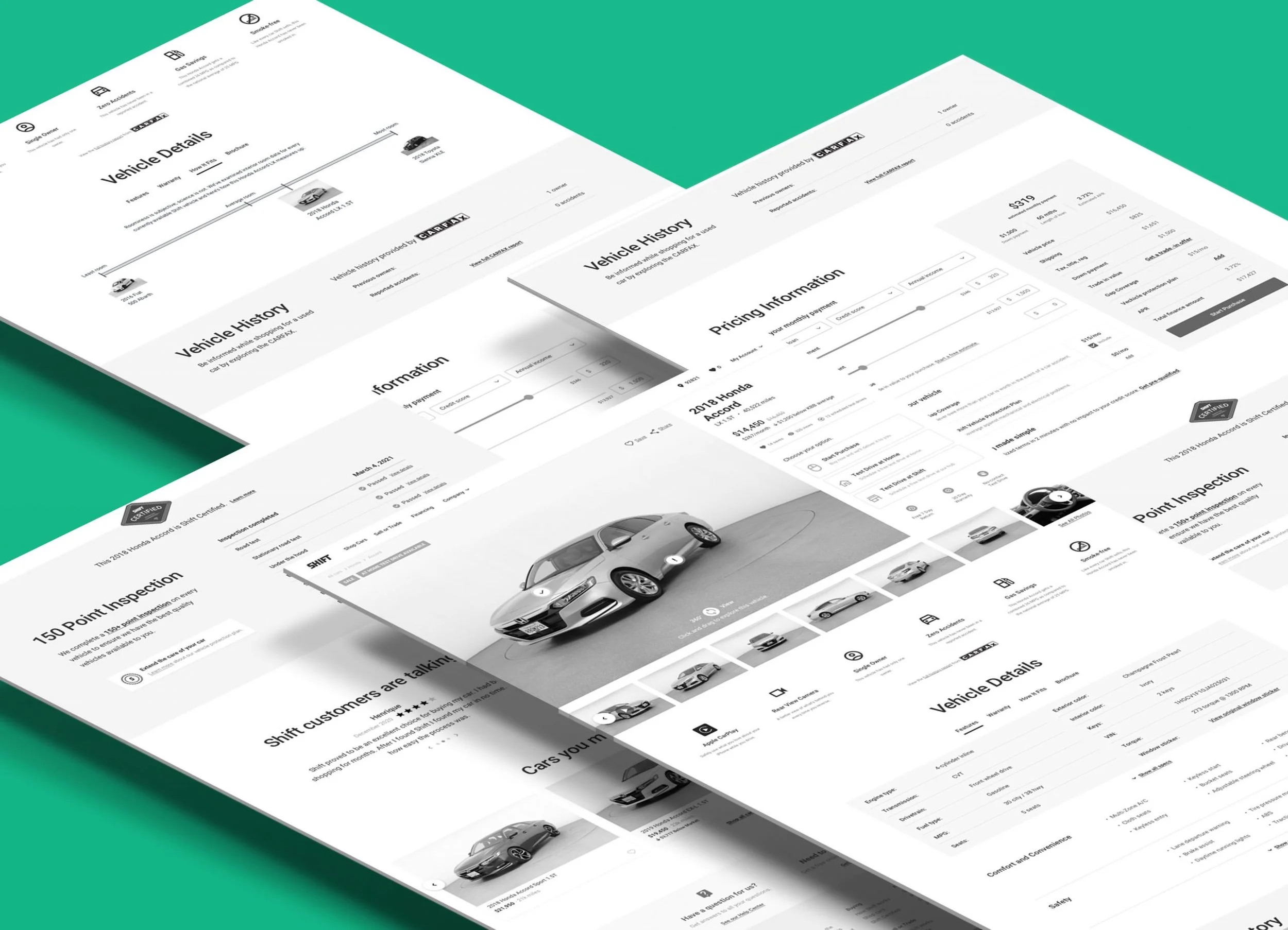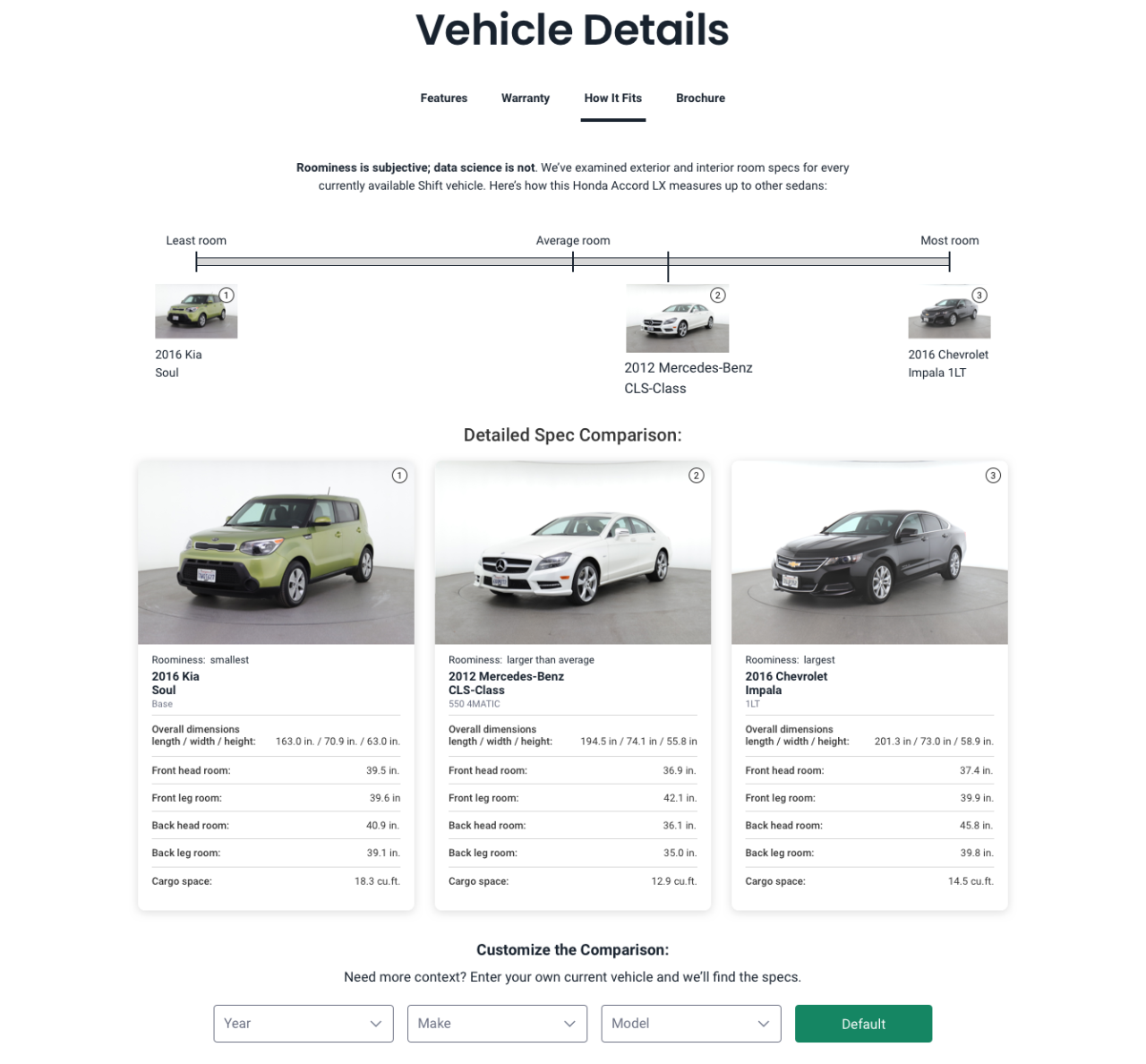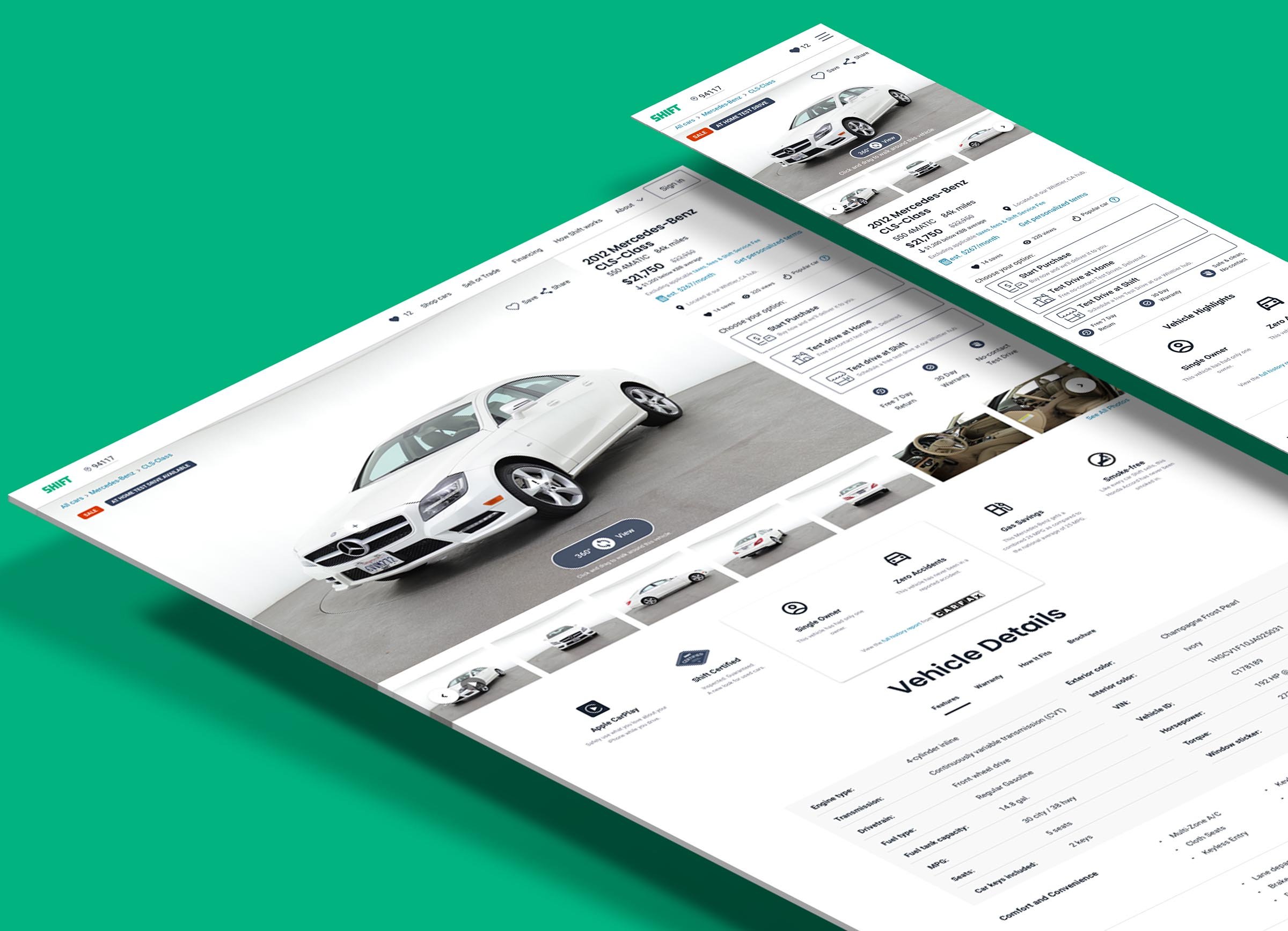
UX Case Study
Shift VDP Redesign
Shift Technologies, Inc. was an “end-to-end auto e-commerce platform transforming the used car industry with a technology-driven, hassle-free customer experience.”
Introduction
Like other ecommerce product pages, online purchases take place on the Vehicle Description Page (VDP). The VDP has multiple functions, not just providing information about the vehicle. In many use cases, the VDP also does the heavy lifting of introducing the user to the Shift brand and unique value propositions. With the end goal being building user trust in Shift as a used car retailer. This is especially true for third-party visitors that link directly to the VDP, bypassing more traditional brand engagement opportunities (homepage, about, and other evergreen content pages).
Unlike its direct online-only competitors (Carvana and Vroom), Shift maintained a hybrid business model that didn’t readily translate to a clear user mental model. In addition to online vehicle purchases, Shift delivered free test drives (limited to customers only within the delivery range of a local Shift location, or “hub”) with the immediate opportunity to buy the vehicle “on the spot.” Or a free test drive at a hub (which aligned with a more traditional used car dealership experience).
With Shift’s then-increasing profile (thanks to third-party site placement, social media branding efforts, traditional media coverage, and nationwide television advertising), it was paramount to ensure the VDP was optimized to tell the Shift story, help customers find helpful vehicle information, and convert leads to purchasers.
VDP Redesign Background
Information hierarchy and discoverability in the then-current VDP was problematic. While the VDP did contain a wealth of vehicle information, information important to the customer was difficult to find, hidden inside modals, accordioned sections, or on altogether different subpages. Despite the increase in visitors, there was a decrease in visitor action and an upward-trending bounce rate.
The fulfillment module (where the user could take action to a.) begin purchase or b.) schedule a test drive) was visually crowded and confusing, with potential user actions varying from vehicle to vehicle with no clear explanation of the differences in methods.
Usability testing revealed these user pain points:
Users did not know Test Drive at Hub was an option on the current VDP. 60% of these users would have preferred this to the Test Drive at Home option
Users expressed uncertainty around vehicle and/or hub location
And as a sticky fulfillment module (in web view), this confusion of actions was ever-present to the user.
Problem Statement
“As a Shift customer, I want to see all vehicle information in a clear, well-organized way so I can make the best-informed decision about my purchase.”
Understanding User (Empathize & Design)
A round of qualitative research (November, 2020) led to several key takeaways:
Users were most interested in understanding history, accidents, and maintenance of the vehicle
History, price, mileage, year, model, and photos were consistently the most important things shoppers immediately looked for on the page
Users did not readily understand Shift ships vehicles directly to them
Users were interested in more financing information, looking for the lowest APR, length of financing, and necessary down payment
The following opportunities for VDP were identified:
Vehicle location: provide clarity that vehicles are shipped directly to the customer
Vehicle images: clearly indicate the VDP photo viewer provides a 360° spinner in addition to static images
Vehicle inspection: provide details about ‘when, where, and who’ to build trust and credibility
Pre-qualification: users are unclear about how/when in the purchase flow to get pre-qualified for a car loan. Make this clearer on VDP
Inspection Report: provide clarity in the report sections and user education to make the report understandable and easily digestible
Vehicle fit: provide information in VDP related to how a user might physically fit in a vehicle and explain the roominess of the interior
Vehicle shipping: Clear confusion in the fulfillment module around free test drives vs. delivery fees for purchased vehicles
Mid Fidelity
With a very clear set of categorized user requirements, we undertook execution of mid-fidelity web and mobile web concepts in Sketch.
Design Solution
The solution involved chunking out the page information and reorganizing into discrete sections:
Photo viewer
Fulfillment
Vehicle highlights
Vehicle details [a. Features, b. Warranty, c. How It Fits, d. Brochure]
Vehicle history
Pricing information
Vehicle inspection
Customer reviews
Cross sells
For clarity, each section is illustrated below with the mobile web view.
Photo Viewer
The photo viewer now has a clear indicator of a 360° view. Icons call out links to look under the hood (as well as minor blemishes or damage). Thumbnails for static photos now sit below instead of inside a user-initiated ‘drawer’ modal on top of the 360° viewer.
Fulfillment
The fulfillment module now includes estimated monthly payment and value messaging relative to Kelley Blue Book. A social section calls out number of user views, saves, and test drives: subtle indicators that there is strong interest in the vehicle (and inspiring the user to take action before missing out on a potential purchase).
Perhaps most importantly, the fulfillment option(s) are clearly laid out (and dynamically displayed based on user and vehicle locations): the Start Purchase, Test Drive at Home, and Test Drive at Shift.
Additionally, Shift value props–Free 7 Day Return, 30 Day Warranty, and No-contact Test Drive–are surfaced.
Vehicle highlights
Vehicle highlights important to Shift customers are surfaced just below the photo viewer, providing a quick graphic overview of the most-requested features.
Vehicle Details (Features)
Vehicle details contain four sections: Features, Warranty, How It Fits, and Brochure
Features are organized in a cohesive, easy-to-understand way.
Detailed vehicle specs are standard, but here they are grouped for readability instead of a long scrolling list inside a modal. Additional features are organized into subgroups: Comfort and Convenience, Safety, Technology, Exterior, and Performance.
Vehicle Details (Warranty)
Warranty information–both manufacturer warranty and Shift warranty–is laid out very clearly for the user. Also included is a link to extended warranty information.
Vehicle Details (How It Fits)
How It Fits is an innovative new feature, addressing needs according to user feedback. Users will book test drives and decide on a purchase only after s/he has had the opportunity to physically sit inside the vehicle and assess the interior for fit (provided specs on head room and leg room are provided in inches, but these data points do not make for easy interpretation).
We looked to apparel retail for inspiration: with larger retailers selling multiple apparel brands, ‘fit models’ are shown wearing the garment and context is provided using the model’s measurements and the size of the garment s/he is wearing.
By accessing available vehicle data, we can place the vehicle the user is looking at into a context for fit. How does the vehicle compare to the smallest and largest vehicles in currently available inventory?
Brochure
Brochure provides a downloadable PDF of the original manufacturer’s brochure, covering features of the vehicle not readily available in third party vehicle data sets.
Vehicle History
Vehicle History as provided by CARFAX details ownership and reported accidents. As a trusted source of information, leveraging the CARFAX brand builds user confidence and allows the user to view the full history report in a single click.
Pricing Information
Pricing Information provides a comprehensive breakdown of vehicle price, shipping, taxes, registration and other fees.
By providing estimator tools as a reference, the user can get an estimated monthly payment right in the VDP, based on loan length, down payment, and trade-in value.
150-Point Inspection
Shift claimed all Shift-Certified vehicles undergo a 150-Point inspection. Organized into six subsections, details of the report, including completion date and cosmetic imperfections, are easily accessible by the user.
Customer Reviews
Building additional user confidence are hand-selected customer reviews.
Cross Sells
This section displays similar vehicles (based on internal browsing data) the user might be interested in.
Usability Testing
While the scope of our research project was essentially limited to VDP redesign usability and concept validation, our work yielded a wealth of actionable information that covered brand perception, user sentiment, and where the VDP actually fits in the overall user journey.
Research Objective
Test and validate if the new VDP redesign resolves the outlined problems
Understand the users’ mental model on the VDP to determine the information hierarchy
Collect impressions of clarity around Shift’s fulfillment methods
Gather insight into the users’ needs/pains/jobs during their car shopping journey
Methodology & Participants
Usability Testing & User Interview
1 hour 1:1 remote/ moderated
Mid-fidelity desktop clickable prototype available here.
Mid-fidelity mobile web clickable prototype available here.
Participants Breakdown (16 total):
8 Male
8 Female participants
9 Web + 7 mobile web prototype tests
Shift Customers and Non-Shift Shoppers:
7 Non-Shift car shoppers (researching/ test driving)
9 Shift customers (including 2 app users)
2 Shift customers who are browsing the site
4 Shift customers who test drive but did not purchase (2 are still shopping)
3 Shift customers who very recently purchased through Shift
5 Key Highlights
Test Drive Options on the Current VDP
5/9 Shift test drive & Buyers did not know test drive at the hub was an option on the current VDP. 3/5 who were not aware would have preferred to go into the hub for a test drive.
Vehicle Research is Work
We learned users would rather not have to do their own research. “If I can trust you guys, I don’t want to do the research” – Ryan (test drive with Shift)Trust & Convenience
The new design took many users by surprise with the level of transparency it displayed. (users were not used to car companies doing this) the new VDP design immediately instilled trust.Participants Loved KBB
Kelley Blue Book value, highlights, 150 report, finance breakdown & calculator, the imperfection call-outs in the 150-point inspection report, and free test drives. These were all trust builders.Test Drives preferred
While the 3 fulfillment options were clear on the redesign, buyers gravitated towards the test drive options. 100% online purchase (Buy It Now or BiN) is a new way of thinking for many car shoppers.
Trust as Innovation
Trust Creates Delight, Trust is an Innovation
Shoppers were surprised to see the transparency in the redesign which immediately instilled trust.
KBB value displayed
7 day return/ 30 day warranty
Imperfection call outs on the Shift 150 inspection report (100% users)
Shift certified 150 point inspection list
Price break down, showing all the fees
Photos
Clear test drive options
About Shift’s 150-Point Inspection report:
“That gives me so much confidence in the fact that you were you are looking at everything that you think could be wrong with the car … things that could go wrong with the car have been inspected and this is just such a confidence builder.”- Erik
About Pricing Transparency:
“I liked you had the link for the itemized prices… that’s where I got a lot more confidence on your website, before that I did not know much about your website.” – Raghav
Below Basic Expectations
Traditional dealerships are not meeting the basic expectation. They’ve actually created an expectation of distrust in this industry.
Trust is an Innovation (adds value)
Trusting the buyers brings peace of mind
Less anxiety & time spent on research
Convenience all around
Business Opportunities
Majority of car shoppers are skeptics, being able to trust can build loyalty
Delightful experiences lead to referrals
User Journey Findings
The information about a specific vehicle contained in VDP aligns with the refinement phase of the user journey. Only after the learning phase (covering market research, identifying specific makes and models of interest, and retailers (both traditional brick & mortar dealerships and online retailers), does the user scrutinize VDP info.
Usability Test Learnings
Even with the redesigned fulfillment module, users still expressed some uncertainty.
Trusting the buyers brings peace of mind
Users had questions on the test drive process/ and what to expect:
learn more when they click on the CTA
Would use a chatbot if available
Wants to call someone if there is a number.
Users had uncertainty around where the car / hub was located (an important decision-making factor on where to book a test drive)
Start Purchase CTA feels very committal for shoppers who simply want to test drive
100% of participants wanted to test drive first. Start Purchase is a new way of thinking for many shoppers, questioning the benefit. 15% lightly considered Start Purchase as an option, 0% would actually Start Purchase. That level of trust has not yet been established.
Actionable User Feedback
User feedback on the VDP Redesign provided the following actionable items:
“12 Scheduled test drives” created confusion, anxiety and disappointment (low chance of getting the car) for users. Buyers appreciated knowing it was popular but not much more
0/12 users said they’d click on the brochure
Buyers liked the concept of an improved “How It Fits”. They thought the ability to compare car specs to their own car would be helpful. (Dimensions alone are vague, and a side by side comparison helps them gain a sense of space without having to sit in the car.)
Shoppers also liked “Cars you may like” Interestingly, buyers had different expectation for recommendations. (Why is it not showing: similar price points, body, same year models.)
“Shift customers are talking” was not helpful for car buyers. 100% thought it’d probably be biased and would do this research outside of Shift’s website. Shoppers wanted to see this feature below “Cars you may like”.
Design Revisions
Incorporating user feedback did not substantially alter the VDP redesign, so we were able to make changes while translating the mid-fidelity designs to high fidelity (leveraging the current Shift design library) for handoff to the platform engineering team.
A Revised ‘How It Fits’
Feedback on How It Fits was thoughtful and detailed, prompting us to expand and refine functionality. Users didn’t see the value in comparing available vehicles from different classes; rather they wanted to compare within a specific class, such as how one sedan measures up to another sedan. How It Fits was open to interpretation; some users wondered how a vehicle would fit in their garage, instead of how s/he would fit into it. Users also suggested adding their current vehicle for a more customized comparison.
About Pricing Transparency:
“I liked you had the link for the itemized prices… that’s where I got a lot more confidence on your website, before that I did not know much about your website.” – Raghav
Below Basic Expectations
Traditional dealerships are not meeting the basic expectation. They’ve actually created an expectation of distrust in this industry.
Trust is an Innovation (adds value)
Trusting the buyers brings peace of mind
Less anxiety & time spent on research
Convenience all around
Business Opportunities
Majority of car shoppers are skeptics, being able to trust a seller can build loyalty
Delightful experiences lead to strong word-of-mouth referrals
Final Result
The redesigned VDP had the potential for high impact on the organization, providing the transparency users wanted and building the trustworthiness Shift saw as essential for its future success as a transformative innovator in the auto industry.

